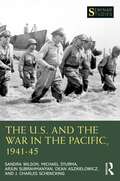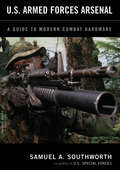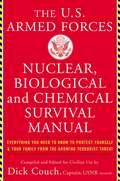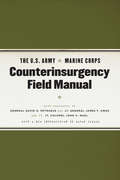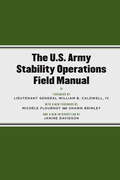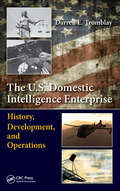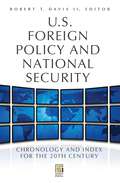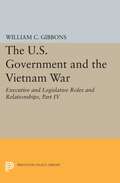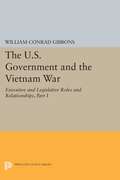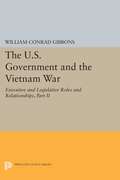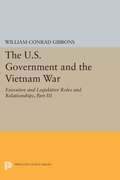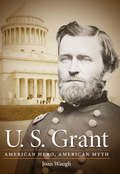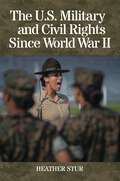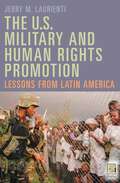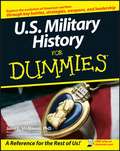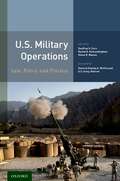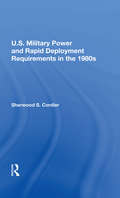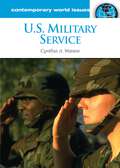- Table View
- List View
The U.S. and the War in the Pacific, 1941–45 (Seminar Studies)
by Sandra Wilson Michael Sturma Arjun Subrahmanyan Dean Aszkielowicz J. Charles SchenckingThe U.S. and the War in the Pacific, 1941-45 analyzes the Pacific War with a focus on America’s participation in the conflict. Fought over a great ocean and vast battlefields using the most sophisticated weapons available, the Pacific War transformed the modern world. Not only did it introduce the atomic bomb to the world, it also reshaped relations among nations and the ways in which governments dealt with their own peoples, changed the balance of power in the Pacific in fundamental ways, and helped to spark nationalist movements throughout Asia. This book examines the strategies, technologies, intelligence capabilities, home-front mobilization, industrial production, and resources that ultimately enabled the United States and its allies to emerge victorious. Major themes include the impact of war, conceptions of race, Japanese perspectives on the conflict, and America’s relations with its allies. Using primary documents, maps, and concise writing, this book provides students with an accessible introduction to an important period in history. Incorporating recent scholarship and conflicting interpretations, the book provides an insightful overview of the topic for students of modern American history, World War II, and the Asia Pacific.
U.S. Armed Forces Arsenal: A Guide To Modern Combat Hardware
by Samuel A. SouthworthToday's arsenal of war contains some of the most sophisticated weapons ever seen on the battlefield. The technological revolution has drastically altered how war is fought and brought about the invention of some highly unusual (and effective) weapons. In the recent war with Iraq, we caught a glimpse of the new high-tech weapons in America's arsenal and the wide-ranging array of modern equipment and transportation used by our armed forces. America's modern military hardware is the envy -and fear-of the world.In U.S. Armed Forces Arsenal, noted military historian Samuel A. Southworth takes the reader on an informal and informative guided tour of this new arsenal of weaponry. He explains in clear and concise prose the new generation of military hardware, from rifles to mortars, jeeps to tanks, robotic drones to night vision sensors, and all manner of bombs, missiles and rockets-the arms and armaments that have reshaped the way the U.S. goes to war, on land and sea and in the air.
U.S. Armed Forces Nuclear, Biological And Chemical Survival Manual
by Captain George GaldorisiIn this comprehensive guide, military experts teach you how to survive an attack on American soil, from North Korean missiles to weaponized smallpoxNorth Korean nukes. Emerging epidemic and pandemic disease. Dirty bombs in train stations. Chemical warfare. Americans have more reasons than ever to be afraid. If a nuclear missile strikes, will you know what to do? If a nerve agent is released in your office building, will you know the best way to avoid harm? The U.S. Armed Forces Nuclear, Biological and Chemical Survival Manual gives you the information you need to survive a terrorist attack. It contains the best practices of all the United States' military services, adapted for the first time for civilian use. Experts agree that the threats posed by terrorists and enemy nations have never been graver. This handbook is the single most effective tool you can own to protect yourself and your family against the danger looming over our homeland.This manual will show you how to:- Protect yourself during a chemical or biological attack- Recognize the indicators of nuclear, chemical and biological attack- Develop a simple and effective family action plan- Guard against the radiological effects of a dirty bomb- Assist victims of nuclear, chemical, or biological agents- Assemble and store the everyday materials that could save your life
The U.S. Army/Marine Corps Counterinsurgency Field Manual
by John A. United States Army United States Marine CorpsWhen the U.S. military invaded Iraq, it lacked a common understanding of the problems inherent in counterinsurgency campaigns. It had neither studied them, nor developed doctrine and tactics to deal with them. It is fair to say that in 2003, most Army officers knew more about the U.S. Civil War than they did about counterinsurgency. The U.S. Army / Marine Corps Counterinsurgency Field Manual was written to fill that void. The result of unprecedented collaboration among top U.S. military experts, scholars, and practitioners in the field, the manual espouses an approach to combat that emphasizes constant adaptation and learning, the importance of decentralized decision-making, the need to understand local politics and customs, and the key role of intelligence in winning the support of the population. The manual also emphasizes the paradoxical and often counterintuitive nature of counterinsurgency operations: sometimes the more you protect your forces, the less secure you are; sometimes the more force you use, the less effective it is; sometimes doing nothing is the best reaction. An new introduction by Sarah Sewall, director of the Carr Center for Human Rights Policy at Harvard’s Kennedy School of Government, places the manual in critical and historical perspective, explaining the significance and potential impact of this revolutionary challenge to conventional U.S. military doctrine. An attempt by our military to redefine itself in the aftermath of 9/11 and the new world of international terrorism, The U.S. Army / Marine Corps Counterinsurgency Field Manual will play a vital role in American military campaigns for years to come. The University of Chicago Press will donate a portion of the proceeds from this book to the Fisher House Foundation, a private-public partnership that supports the families of America’s injured servicemen. To learn more about the Fisher House Foundation, visit www.fisherhouse.org.
The U.S. Army Stability Operations Field Manual: U.S. Army Field Manual No. 3-07 (U.S. Army field manual ; #No. 3-07)
by William B Caldwell IV Michèle Flournoy Shawn Brimley Janine DavidsonField Manual 3-07, Stability Operations, represents a milestone in Army doctrine. With a focus on transforming conflict, managing violence when it does occur and maintaining stable peace, The U.S. Army Stability Operations Field Manual (otherwise known as FM 3-07) signals a stark departure from traditional military doctrine. The Army officially acknowledges the complex continuum from conflict to peace, outlines the military's responsibility to provide stability and security, and recognizes the necessity of collaboration, coordination, and cooperation among military, state, commercial, and non-government organizations in nation-building efforts. The manual reflects a truly unique collaboration between the Army and a wide array of experts from hundreds of groups across the United States Government, the intergovernmental and non-governmental communities, America's allies around the world, and the private sector. All branches of the armed forces, U.S. agencies ranging from the State Department to Homeland Security to Health and Human Services, international agencies from the United Nations to the Red Cross to the World Bank, countries from the United Kingdom to India to South Africa, private think tanks from RAND to the United States Institute of Peace to the Center for New American Security, all took part in the shaping of this document. The U.S. Army Stability Operations FieldManual, marks just the second time in modern history that the U.S. Army has worked with a private publisher to produce a military doctrinal document. Lieutenant General William B. Caldwell, IV is Commander of the Combined Arms Center at Fort Leavenworth, Kansas. Michèle Flournoy, Under Secretary of Defense for Policy Shawn Brimley, Fellow, Center for a New American Security Janine Davidson, Deputy Assistant Secretary of Defense for Plans "It is a roadmap from conflict to peace, a practical guidebook for adaptive, creative leadership at a critical time in our history. It institutionalizes the hard-won lessons of the past while charting a path for tomorrow. This manual postures our military forces for the challenges of an uncertain future, an era of persistent conflict where the unflagging bravery of our Soldiers will continue to carry the banner of freedom, hope, and opportunity to the people of the world." —From the foreword by Lieutenant General William B. Caldwell, IV, Commander of the Combined Arms Center at Fort Leavenworth, Kansas
U.S. Civil War Battle by Battle
by Iain MacGregor'Just the thing for US Civil War buffs: snappily written, informative and entertaining. A cracking read.' Saul David, bestselling author and historianThis attractively packaged gift book offers a highly illustrated introduction to some of the U.S. Civil War's most famous and important battles, from the Battle of Fort Sumter in 1861 to the Battle of Appomatox Court House in 1865.The U.S. Civil War was the most cataclysmic military struggle of the late 19th century, and in four bloody years of fighting from 1861 to 1865 over 620,000 American soldiers and sailors lost their lives in more than 8,000 battles, engagements and skirmishes. U.S. Civil War Battle by Battle tells the story of 30 of the most significant of these battles. These include some of the most famous clashes, such as the battles of Gettysburg and Fredericksburg, which resonate through American military history, but also the less well known, such as the battles of Brandy Station and Cedar Creek. This highly illustrated introduction, packed full of colour artwork, covers every theatre of the war and details infantry, cavalry, artillery and seaborne units from both the Union and the Confederate forces to give a true sense of the scale of the War between the States.
U.S. Civil War Battle by Battle
by Iain MacGregor'Just the thing for US Civil War buffs: snappily written, informative and entertaining. A cracking read.' Saul David, bestselling author and historianThis attractively packaged gift book offers a highly illustrated introduction to some of the U.S. Civil War's most famous and important battles, from the Battle of Fort Sumter in 1861 to the Battle of Appomatox Court House in 1865.The U.S. Civil War was the most cataclysmic military struggle of the late 19th century, and in four bloody years of fighting from 1861 to 1865 over 620,000 American soldiers and sailors lost their lives in more than 8,000 battles, engagements and skirmishes. U.S. Civil War Battle by Battle tells the story of 30 of the most significant of these battles. These include some of the most famous clashes, such as the battles of Gettysburg and Fredericksburg, which resonate through American military history, but also the less well known, such as the battles of Brandy Station and Cedar Creek. This highly illustrated introduction, packed full of colour artwork, covers every theatre of the war and details infantry, cavalry, artillery and seaborne units from both the Union and the Confederate forces to give a true sense of the scale of the War between the States.
The U.S. Domestic Intelligence Enterprise: History, Development, and Operations
by Darren E. TromblayMuch has been written about U.S. intelligence operations. However, intelligence, as it is conducted in the U.S. domestic environment, has usually been treated in a fractured and sensationalistic manner. This book dispassionately assesses the U.S. domestically oriented intelligence enterprise by first examining its individual components and then sho
U.S. Foreign Policy and National Security [2 volumes]: Chronology and Index for the 20th Century [2 volumes] (Praeger Security International)
by Robert T. IIThis comprehensive guide provides an in-depth, chronological overview of issues and policy processes related to U.S. foreign, military, and national security policy during the 20th century.U.S. Foreign Policy and National Security: Chronology and Index for the 20th Century provides a unique compilation of data never before combined in a single volume. Key events and policy meetings are arranged in order by presidential administration, from the McKinley administration to that of President Obama. Each section begins with a concise list of policymakers, including Cabinet-level officials, members of the National Security Council, and senior ranks of the Department of State and Department of Defense, supplemented with bibliographic data. The bulk of each chapter is comprised of detailed lists of meetings of the president of the United States with key advisors and foreign dignitaries. These meetings include international conferences, meetings between the president and foreign leaders, meetings of the joint chiefs of staff in World War II, and meetings of the National Security Council since its creation in 1947. This unprecedented guide will be invaluable to researchers and, indeed, to anyone interested in the decisions that determined the course of U.S. history.
The U.S. Government and the Vietnam War: July 1965-January 1968
by William Conrad GibbonsThis fourth volume of a five-part policy history of the U.S. government and the Vietnam War covers the core period of U.S. involvement, from July 1965, when the decision was made to send large-scale U.S. forces, to the beginning of 1968, just before the Tet offensive and the decision to seek a negotiated settlement. Using a wide variety of archival sources and interviews, the book examines in detail the decisions of the president, relations between the president and Congress, and the growth of public and congressional opposition to the war. Differences between U.S. military leaders on how the war should be fought are also included, as well as military planning and operations.Among many other important subjects, the financial effects of the war and of raising taxes are considered, as well as the impact of a tax increase on congressional and public support for the war. Another major interest is the effort by Congress to influence the conduct of the war and to place various controls on U.S. goals and operations. The emphasis throughout this richly textured narrative is on providing a better understanding of the choices facing the United States and the way in which U.S. policymakers tried to find an effective politico-military strategy, while also probing for a diplomatic settlement.Originally published in 1995.The Princeton Legacy Library uses the latest print-on-demand technology to again make available previously out-of-print books from the distinguished backlist of Princeton University Press. These editions preserve the original texts of these important books while presenting them in durable paperback and hardcover editions. The goal of the Princeton Legacy Library is to vastly increase access to the rich scholarly heritage found in the thousands of books published by Princeton University Press since its founding in 1905.
The U.S. Government and the Vietnam War: 1945-1960
by William Conrad GibbonsThis searching analysis of what has been called America's longest war" was commissioned by the Senate Committee on Foreign Relations to achieve an improved understanding of American participation in the conflict. Part I begins with Truman's decision at the end of World War II to accept French reoccupation of Indochina, rather than to seek the international trusteeship favored earlier by Roosevelt. It then discusses U.S. support of the French role and U.S. determination to curtail Communist expansion in Asia.Originally published in 1986.The Princeton Legacy Library uses the latest print-on-demand technology to again make available previously out-of-print books from the distinguished backlist of Princeton University Press. These editions preserve the original texts of these important books while presenting them in durable paperback and hardcover editions. The goal of the Princeton Legacy Library is to vastly increase access to the rich scholarly heritage found in the thousands of books published by Princeton University Press since its founding in 1905.
The U.S. Government and the Vietnam War: 1961-1964
by William Conrad GibbonsThis searching analysis of what has been called America's longest war" was commissioned by the Senate Committee on Foreign Relations to achieve an improved understanding of American participation in the conflict. Part II covers the period from Kennedy's inauguration through Johnson's first year in office.Originally published in 1986.The Princeton Legacy Library uses the latest print-on-demand technology to again make available previously out-of-print books from the distinguished backlist of Princeton University Press. These editions preserve the original texts of these important books while presenting them in durable paperback and hardcover editions. The goal of the Princeton Legacy Library is to vastly increase access to the rich scholarly heritage found in the thousands of books published by Princeton University Press since its founding in 1905.
The U.S. Government and the Vietnam War: 1965-1966
by William Conrad GibbonsPart III, which begins in January 1965 and ends in January 1967, treats the watershed period of U.S. involvement in the war, from President Johnson's decision to bomb North Vietnam and to send U.S. ground forces into South Vietnam, through the buildup of military forces and political cadres required by the new U.S. role in the war. This volume examines Johnson's policymaking, his interaction with military advisors and with Congressional critics such as Mike Mansfield, and his reactions as protests against the war began to grow.Originally published in 1989.The Princeton Legacy Library uses the latest print-on-demand technology to again make available previously out-of-print books from the distinguished backlist of Princeton University Press. These editions preserve the original texts of these important books while presenting them in durable paperback and hardcover editions. The goal of the Princeton Legacy Library is to vastly increase access to the rich scholarly heritage found in the thousands of books published by Princeton University Press since its founding in 1905.
U. S. Grant: American Hero, American Myth (Civil War America)
by Joan WaughAt the time of his death, Ulysses S. Grant was the most famous person in America, considered by most citizens to be equal in stature to George Washington and Abraham Lincoln. Yet today his monuments are rarely visited, his military reputation is overshadowed by that of Robert E. Lee, and his presidency is permanently mired at the bottom of historical rankings.In an insightful blend of biography and cultural history, Joan Waugh traces Grant's shifting national and international reputation, illuminating the role of memory in our understanding of American history. Using a wide range of written and visual sources--newspaper articles, private and public reminiscences, photographs, paintings, cartoons, poetry, and much more--Waugh reveals how Grant became the embodiment of the American nation in the decades after the Civil War. She does not paper over Grant's image as a scandal-ridden contributor to the worst excesses of the Gilded Age. Instead, she captures a sense of what led nineteenth-century Americans to overlook Grant's obvious faults and hold him up as a critically important symbol of national reconciliation and unity. Waugh further shows that Grant's reputation and place in public memory closely parallel the rise and fall of the northern version of the Civil War story--in which the United States was the clear, morally superior victor and Grant was the symbol of that victory. By the 1880s, Waugh shows, after the failure of Reconstruction, the dominant Union myths about the war gave way to a southern version that emphasized a more sentimental remembrance of the honor and courage of both sides and ennobled the "Lost Cause." During this social transformation, Grant's public image changed as well. By the 1920s, his reputation had plummeted.Most Americans today are unaware of how revered Grant was in his lifetime. Joan Waugh uncovers the reasons behind the rise and fall of his renown, underscoring as well the fluctuating memory of the Civil War itself.
U.S. Marines and Amphibious Warfare
by Jeter A. Isely Philip A. Crowl"Not only a just appraisal of the campaigns waged by Marines in World War II; it is a documentation of the Marine struggle to prove the feasibility of amphibious warfare.... Relentlessly accurate and impartial." —N.Y. Times.Originally published in 1951.The Princeton Legacy Library uses the latest print-on-demand technology to again make available previously out-of-print books from the distinguished backlist of Princeton University Press. These editions preserve the original texts of these important books while presenting them in durable paperback and hardcover editions. The goal of the Princeton Legacy Library is to vastly increase access to the rich scholarly heritage found in the thousands of books published by Princeton University Press since its founding in 1905.
The U.S. Military and Civil Rights Since World War II
by Heather SturThrough examinations of U.S. military racial and gender integration efforts and its handling of sexuality, this book argues that the need for personnel filling the ranks has forced the armed services to be pragmatically progressive since World War II.The integration of African Americans and women into the United States Armed Forces after World War II coincided with major social movements in which marginalized civilians demanded equal citizenship rights. As this book explores, due to personnel needs, the military was a leading institution in its opening of positions to women and African Americans and its offering of educational and economic opportunities that in many cases were not available to them in the civilian world. By opening positions to African Americans and women and remaking its "where boys become men" image, the military was an institutional leader on the issue of social equality in the second half of the 20th century. The pushback against gay men and women wishing to serve openly in the forces, however, revealed the limits of the military's pragmatic progressivism. This text investigates how policymakers have defined who belongs in the military and counts as a soldier, and examines how the need to attract new recruits led to the opening of the forces to marginalized groups and the rebranding of the services.
The U.S. Military and Civil Rights Since World War II
by Heather SturThrough examinations of U.S. military racial and gender integration efforts and its handling of sexuality, this book argues that the need for personnel filling the ranks has forced the armed services to be pragmatically progressive since World War II.The integration of African Americans and women into the United States Armed Forces after World War II coincided with major social movements in which marginalized civilians demanded equal citizenship rights. As this book explores, due to personnel needs, the military was a leading institution in its opening of positions to women and African Americans and its offering of educational and economic opportunities that in many cases were not available to them in the civilian world. By opening positions to African Americans and women and remaking its "where boys become men" image, the military was an institutional leader on the issue of social equality in the second half of the 20th century. The pushback against gay men and women wishing to serve openly in the forces, however, revealed the limits of the military's pragmatic progressivism. This text investigates how policymakers have defined who belongs in the military and counts as a soldier, and examines how the need to attract new recruits led to the opening of the forces to marginalized groups and the rebranding of the services.
The U.S. Military and Human Rights Promotion: Lessons from Latin America (Praeger Security International)
by Jerry LaurientiMany years before the U.S. military had to deal with the repercussions of abuses at Abu Ghraib prison in Iraq, the U.S. armed forces were vigorously engaged in helping their Latin American counterparts to recognize the strategic imperatives of respecting human rights on the battlefield. Before Iraqi accusations of massacre at Haditha forced the U.S. military to again scramble to defend its honor and reputation, U.S. forces in Latin America were more than a decade into repairing their image after taking the blame for numerous human rights crises. Indeed, U.S. military relations with Latin America are at the center of numerous academic and policy debates, particularly regarding U.S. military assistance and its impact on human rights and broader democratic development. Until now, however, no book has focused on determining whether the U.S. military could serve as a primary source of human rights promotion. Meanwhile, U.S. military human rights promotion efforts in Latin America have become central to the Department of Defense Strategic Engagement Plan since the end of the Cold War.The significant role of the U.S. military in promoting human rights around Latin America is unmatched by U.S. military efforts anywhere in the world. This book documents an approach to human rights that could become a model for Department of Defense strategy and behavior around the world. Perhaps the most important finding of this book is that the true heroes on the human rights front are not civilians, but U.S. military officials, a conclusion that is too often ignored by activists, missed by scholars, and would have been unthinkable only a decade ago.
U.S. Military History For Dummies (For Dummies)
by John C. McManusWant to know more about American military history? U.S. Military History For Dummies presents concise and revealing accounts of all of the nation's armed conflicts from the French and Indian War to Iraq. It explains how the U.S. military is organized and how its branches operate, both independently and together. This straightforward guide examines the causes for each of America's wars and reveals how these conflicts have shaped the nation's borders, society, politics, culture, and future. You'll meet heroes, cowards, patriots, and traitors; relive great battles; and get a taste of what combat is really like, as you discover: How the French/Indian war sowed the seeds of the Revolutionary War Why America's battle for independence didn't end at Yorktown Early U.S. wars against Indians, tax cheats, and pirates The War of 1812: guaranteeing U.S. sovereignty "Manifest Destiny" wars that stretched America from sea to shining sea Why the American Civil War could not be avoided The Spanish American War and the U.S. as an emerging global power Why World War I failed to "make the world safe for democracy" How World War II changed America's role in the world Korea and Vietnam: hot wars during the Cold War Featuring important insights on technological, political, and social changes that transformed the way America fights its wars U.S. Military History For Dummies is your key to understanding the evolution of the most powerful military force in history.
U.S. Military Operations: Law, Policy, and Practice
In U.S. Military Operations: Law, Policy, and Practice, a distinguished group of military experts comprehensively analyze how the law is applied during military operations on and off the battlefield. Subject matter experts offer a unique insiders perspective on how the law is actually implemented in a wide swath of military activities, such as how the law of war applies in the context of multi-state coalition forces, and whether non-governmental organizations involved in quasi-military operations are subject to the same law. The book goes on to consider whether U.S. Constitutional 4th Amendment protections apply to the military's cyber-defense measures, how the law guides targeting decisions, and whether United Nations mandates constitute binding rules of international humanitarian law. Other areas of focus include how the United States interacts with the International Committee of the Red Cross regarding its international legal obligations, and how courts should approach civil claims based on war-related torts. This book also answers questions regarding how the law of armed conflict applies to such extra-conflict acts as intercepting pirates and providing humanitarian relief to civilians in occupied territory.
U.S. MILITARY OPERATIONS C: Law, Policy, and Practice
by Geoffrey S. Corn, Rachel E. VanLandingham and Shane R. ReevesIn U.S. Military Operations: Law, Policy, and Practice, a distinguished group of military experts comprehensively analyze how the law is applied during military operations on and off the battlefield. Subject matter experts offer a unique insiders perspective on how the law is actually implemented in a wide swath of military activities, such as how the law of war applies in the context of multi-state coalition forces, and whether non-governmental organizations involved in quasi-military operations are subject to the same law. The book goes on to consider whether U.S. Constitutional 4th Amendment protections apply to the military's cyber-defense measures, how the law guides targeting decisions, and whether United Nations mandates constitute binding rules of international humanitarian law. Other areas of focus include how the United States interacts with the International Committee of the Red Cross regarding its international legal obligations, and how courts should approach civil claims based on war-related torts. This book also answers questions regarding how the law of armed conflict applies to such extra-conflict acts as intercepting pirates and providing humanitarian relief to civilians in occupied territory.
U.s. Military Power And Rapid Deployment Requirements In The 1980s
by Sherwood S CordierThis book assesses U.S. military needs in the coming decade, focusing on the role of rapid deployment forces in protecting U.S. interests abroad. Dr. Cordier begins by discussing two general developments crucial to future military requirements: first, increasing U.S. dependence on the global sea-lanes as links to key markets; and second, improved S
U.s. Military Power And Rapid Deployment Requirements In The 1980s
by Sherwood S CordierThis book assesses U.S. military needs in the coming decade, focusing on the role of rapid deployment forces in protecting U.S. interests abroad. Dr. Cordier begins by discussing two general developments crucial to future military requirements: first, increasing U.S. dependence on the global sea-lanes as links to key markets; and second, improved S
U.S. Military Service: A Reference Handbook (Contemporary World Issues)
by Cynthia A. WatsonThis work is a fascinating overview of Americans' complex and occasionally uneasy relationship with military service, from World War II to the age of global terrorism.The end of the Cold War ushered in a new kind of war that has already made conventional tactics and strategy obsolete. How has the U.S. military responded?In U.S. Military Service: A Reference Handbook, Cynthia Watson, professor of strategy at the National War College, analyzes the major issues that are reshaping the military in the era of global terrorism—problems of recruitment, urban warfare, effective use of electronic media, and rebuilding failed states. She also examines the unprecedented policy of relinquishing military duties to the for-profit sector, which has occurred in both Afghanistan and Iraq. Through a combination of detailed analysis and broad overview, the work shows how the U.S. military is quickly transforming itself into a leaner, more agile force.
The U.S. Navy: A Concise History
by Craig L. SymondsThis fast-paced narrative traces the emergence of the United States Navy as a global power from its birth during the American Revolution through to its current superpower status. The story highlights iconic moments of great drama pivotal to the nation's fortunes: John Paul Jones' attacks on the British in the Revolution, the Barbary Wars, and the arduous conquest of Iwo Jima. The book illuminates the changes--technological, institutional, and functional--of the U.S. Navy from its days as a small frigate navy through the age of steam and steel to the modern era of electronics and missiles. Historian Craig L. Symonds captures the evolving culture of the Navy and debates between policymakers about what role the institution should play in world affairs. Internal and external challenges dramatically altered the size and character of the Navy, with long periods of quiet inertia alternating with rapid expansion emerging out of crises. The history of the navy reflects the history of the nation as a whole, and its many changes derive in large part from the changing role of the United States itself.
